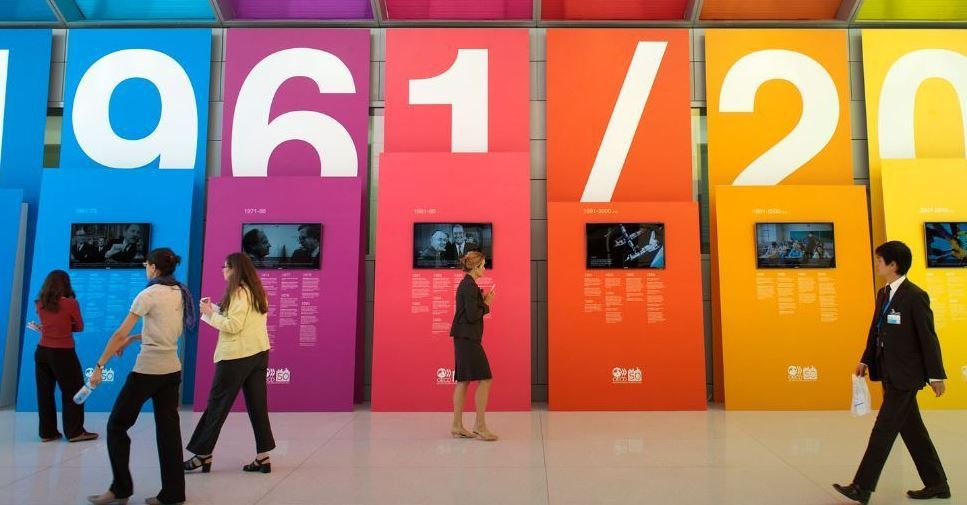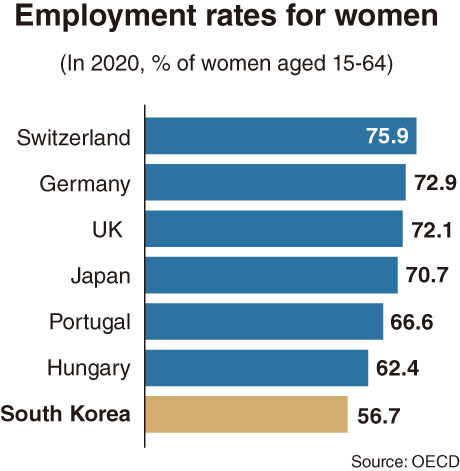
SEJONG -- The hiring market for women has been relatively tough in South Korea, compared to Western countries. This could also be seen in global comparison data.
According to the Organization for Economic Cooperation and Development, Korea posted a 56.7 percent employment rate for women in the working age population of 15-64 in 2020.
Korea placed No. 30 among the 36 OECD members for the female employment rate. Of the total 37 members, last year’s figure for Mexico has yet to be compiled.
Korea has far lagged behind its Asia-Pacific neighbors: 72.2 percent was reported in New Zealand, 70.7 percent in Japan and 68.6 percent in Australia.
Some emerging economies also outstripped Korea, including Lithuania with 71 percent in the female employment rate, Estonia with 71 percent, Latvia with 70.2 percent and Slovenia with 67.8 percent.
According to the Organization for Economic Cooperation and Development, Korea posted a 56.7 percent employment rate for women in the working age population of 15-64 in 2020.
Korea placed No. 30 among the 36 OECD members for the female employment rate. Of the total 37 members, last year’s figure for Mexico has yet to be compiled.
Korea has far lagged behind its Asia-Pacific neighbors: 72.2 percent was reported in New Zealand, 70.7 percent in Japan and 68.6 percent in Australia.
Some emerging economies also outstripped Korea, including Lithuania with 71 percent in the female employment rate, Estonia with 71 percent, Latvia with 70.2 percent and Slovenia with 67.8 percent.

Among those ranking above Korea were the Czech Republic (67.1 percent), Hungary (62.4 percent), Slovakia (61.6 percent) and Poland (61.5 percent).
Iceland topped the list last year at 77.8 percent, followed by Switzerland at 75.9 percent, the Netherlands at 73.9 percent, Sweden at 73.5 percent, Germany at 72.9 percent and Norway at 72.7 percent.
Among English-speaking countries, a figure of 72.1 percent was seen for the UK, 66.8 percent in Canada, 62.4 percent in Ireland and 62.2 percent in the US.
In contrast, Korea ranked No. 17 in the employment rate for men among the 36 OECD members (excluding Mexico of the total 37) with 74.8 percent in 2020.
This showed an apparent disparity for hiring conditions between men and women in the nation. The situation had continued before the COVID-19 pandemic hit the world.
Nonetheless, Korea fell short of figures for the male employment in Japan (No. 2 with 83.9 percent), New Zealand (No. 5 with 81.5 percent), the Czech Republic (No. 6 with 81.4 percent) and the UK (No. 8 with 79.1 percent).
Among the top 10 were Switzerland (No. 1 with 83.9 percent), Iceland, the Netherlands, Germany, Sweden and Denmark.
According to the Supplementary Index III for Employment, held by Statistics Korea, the de facto jobless rate -- unemployed plus underemployed -- for both men and women was 13.5 percent as of May.
Index III refers to the extended-based jobless rate, which reflects “underemployment” as well as unemployment. People deemed to be among the jobless include temporary employees who work fewer than 36 hours a week and want to work more hours, as well as seasonal workers who are out of work for part of the year.
This indicates that 4.12 million Koreans of the economically active population of 30.5 million were de facto unemployed.
This contrasts from the nation’s official jobless rate of 3.7 percent and the tally for jobless, 1.14 million, publicized by the government.
Women also have been hit harder by the pandemic than their male counterparts in terms of job security, labor-related government data suggested.
According to the Korea Employment Information Service, payouts of unemployment benefits grew at a faster pace among women than men in most cities and provinces across the nation.
In Seoul, the number of men receiving unemployment benefits recorded 64,339 in April 2021, up 62.3 percent from 39,633 in December 2019. The first case of COVID-19 was reported here in January 2020.
In contrast, the increase amounted to 88.2 percent for women during the same time frame, with the tally of recipients increasing from 40,851 women to 76,915 women.
The corresponding figures were 62.4 percent among men vs. 78.1 percent among women in Gyeonggi Province, and 68.4 percent among men vs. 96.6 percent among women in Sejong.








![[Today’s K-pop] BTS pop-up event to come to Seoul](http://res.heraldm.com/phpwas/restmb_idxmake.php?idx=644&simg=/content/image/2024/04/17/20240417050734_0.jpg&u=)

![[Graphic News] More Koreans say they plan long-distance trips this year](http://res.heraldm.com/phpwas/restmb_idxmake.php?idx=644&simg=/content/image/2024/04/17/20240417050828_0.gif&u=)





![[KH Explains] Hyundai's full hybrid edge to pay off amid slow transition to pure EVs](http://res.heraldm.com/phpwas/restmb_idxmake.php?idx=652&simg=/content/image/2024/04/18/20240418050645_0.jpg&u=20240419100350)

